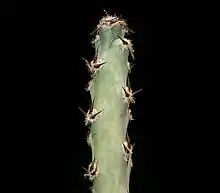| Cereus spegazzinii | |
|---|---|
 | |
| Scientific classification | |
| Kingdom: | Plantae |
| Clade: | Tracheophytes |
| Clade: | Angiosperms |
| Clade: | Eudicots |
| Order: | Caryophyllales |
| Family: | Cactaceae |
| Subfamily: | Cactoideae |
| Genus: | Cereus |
| Species: | C. spegazzinii |
| Binomial name | |
| Cereus spegazzinii F.A.C. Weber 1899 | |
| Synonyms | |
| |
Cereus spegazzinii is a species of cactus found in Argentina, Bolivia, Brazil and Paraguay.[2]
Description
Cereus spegazzinii is a cactus that grows and branches abundantly. It is erect, sloping or almost creeping, with many cylindrical stems, of blue-green color often of glossy marble color. They grow up to 2 m in length and have a diameter of up to 6.5 cm. It has three to five ribs with very wide areoles. The first with two to three spines, and later with six blackish spines, and up to 1.5 cm in length. The flowers are white are 10 to 13 cm long and have a diameter of 7 to 9 cm. The fruits are pink ellipsoids.[3]
Distribution
Cereus spegazzinii is distributed in Brazil in Mato Grosso do Sul, in Paraguay, in Bolivia and in northern Argentina at altitudes of up to 1400 meters.
The plant was first described and published in 1899 by Frédéric Albert Constantin Weber.[4] Nomenclature synonyms are Piptanthocereus spegazzinii (F.A.C.Weber) Riccob. (1909) and Monvillea spegazzinii (F.A.C.Weber) Britton & Rose (1920).
The species is classified as Least Concern (LC) in the IUCN Red List of Threatened Species.
References
- ↑ "The IUCN Red List of Threatened Species". IUCN Red List of Threatened Species. 2010-09-21. Retrieved 2023-08-13.
- ↑ Tropicos entry for Cereus spegazzinii
- ↑ Anderson, Edward F.; Eggli, Urs (2005). Das grosse Kakteen-Lexikon (in German). p. 111. ISBN 3-8001-4573-1.
- ↑ "Monatsschrift für Kakteenkunde". J. Neumann. 1899. Retrieved 2023-08-13.
External links
 Media related to Cereus spegazzinii at Wikimedia Commons
Media related to Cereus spegazzinii at Wikimedia Commons Data related to Cereus spegazzinii at Wikispecies
Data related to Cereus spegazzinii at Wikispecies
